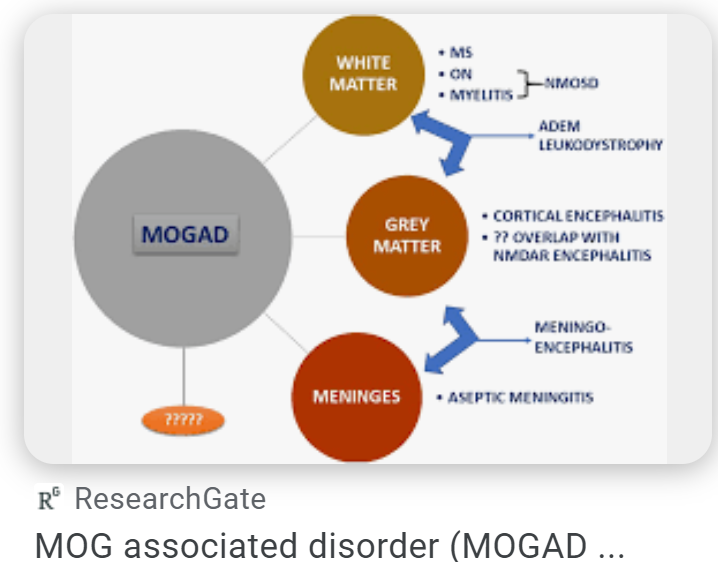This is a PubMed Article: https://pubmed.ncbi.nlm.nih.gov/37402345/
Qiao Xu 1, Xixi Yang 1, Zhandong Qiu 1, Dawei Li 1, Hongxing Wang 1, Hong Ye 1, Lidong Jiao 1, Jing Zhang 1, Li Di 1, Peng Lei 2, Huiqing Dong 1, Zheng Liu 3
- PMID: 37402345
- DOI: 10.1016/j.msard.2023.104797
Abstract
Objective: To assess the characteristics of Myelin oligodendrocyte glycoprotein (MOG) antibody-associated disorder (MOGAD) with brainstem involvement in the first event (BSIFE) and make comparisons with aquaporin-4-IgG seropositive neuromyelitis optica spectrum disorder (AQP4-IgG-NMOSD) and multiple sclerosis (MS).
Methods: From 2017 to 2022, this study identified MOG-IgG-positive patients with brainstem or both brainstem and cerebellum lesions in the first episode. As a comparison group, AQP4-IgG-NMOSD (n = 30) and MS (n = 30) patients with BSIFE were enroled.
Results: Thirty-five patients (35/146, 24.0%) were the BSIFE of MOGAD. Isolated brainstem episodes occurred in 9 of the 35 (25.7%) MOGAD patients, which was similar to MS (7/30, 23.3%) but was lower than AQP4-IgG-NMOSD (17/30, 56.7%, P = 0.011). Pons (21/35, 60.0%), medulla oblongata (20/35, 57.1%) and middle cerebellar peduncle (MCP, 19/35, 54.3%) were the most frequently affected areas. Intractable nausea (n = 7), vomiting (n = 8) and hiccups (n = 2) happened in MOGAD patients, but EDSS of MOGAD was lower than AQP4-IgG-NMOSD (P = 0.001) at the last follow-up. MOGAD patients with or without BSIFE did not significantly differ in terms of the ARR (P = 0.102), mRS (P = 0.823), or EDSS (P = 0.598) at the most recent follow-up. Specific oligoclonal bands appeared in MOGAD (13/33, 39.4%) and AQP4-IgG-NMOSD (7/24, 29.2%) in addition to MS (20/30, 66.7%). Fourteen MOGAD patients (40.0%) experienced relapse in this study. When the brainstem was involved in the first attack, there was an increased likelihood of a second attack occurring at the same location (OR=12.22, 95%CI 2.79 to 53.59, P = 0.001). If the first and second events were both in the brainstem, the third event was likely to occur at the same location (OR=66.00, 95%CI 3.47 to 1254.57, P = 0.005). Four patients experienced relapses after the MOG-IgG turned negative.
Conclusion: BSIFE occurred in 24.0% of MOGAD. Pons, medulla oblongata and MCP were the most frequently involved regions. Intractable nausea, vomiting and hiccups occurred in MOGAD and AQP4-IgG-NMOSD, but not MS. The prognosis of MOGAD was better than AQP4-IgG-NMOSD. In contrast to MS, BSIFE may not indicate a worse prognosis for MOGAD. When patients with BSIFE, MOGAD tent to reoccur in the brainstem. Four of the 14 recurring MOGAD patients relapsed after the MOG-IgG test turned negative.
Keywords: Brainstem; Demyelinating diseases; Multiple sclerosis (MS); Myelin oligodendrocyte glycoprotein (MOG); Neuromyelitis optica spectrum disorder (NMOSD).
#MOGAD #NMOSD #MultipleSclerosis
Stay informed with MS news and information - Sign-up here
For MS patients, caregivers or clinicians, Care to chat about MS? Join Our online COMMUNITY CHAT




